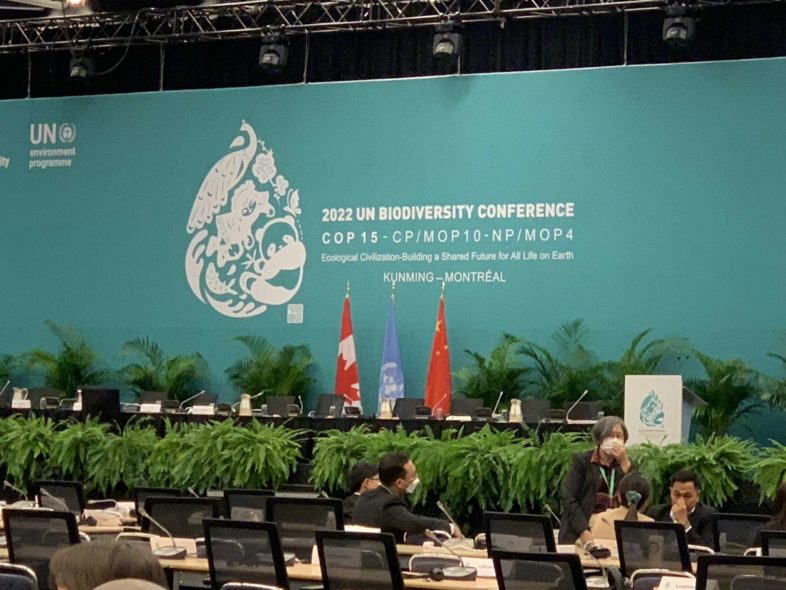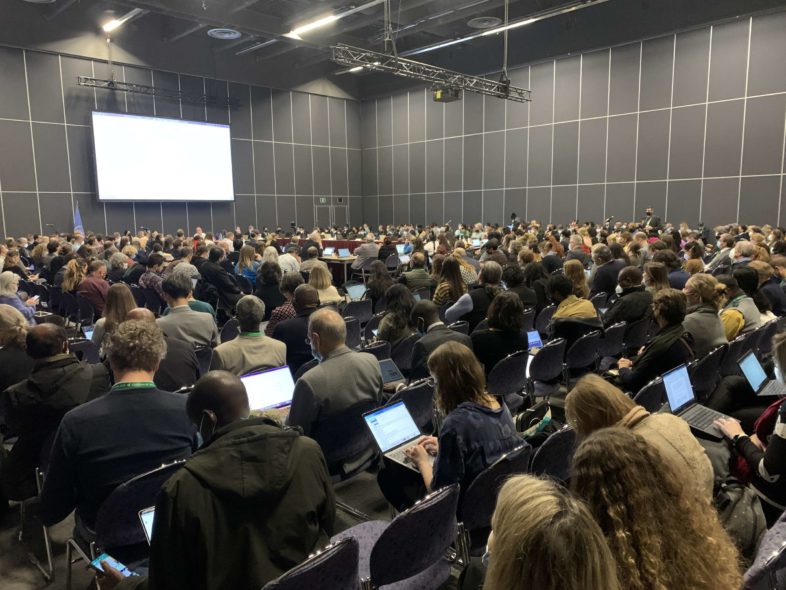
The front of the room where all of the nations meet at COP15. © Susan Hindinger
VCE staff traded flannels and boots for suits and heels last month. The occasion? Attending the 15th Conference of Parties (COP15) in Montreal, CA, where global entities met to finalize the Global Biodiversity Framework (GBF), a list of targets to address catastrophic biodiversity loss worldwide.
Our four-person delegation arrived in the afternoon on Thursday, December 8, one day after the conference began. As small fish in an enormous pond, our primary objectives were to make a few connections, watch some presentations, and perhaps be flies on the wall during party negotiations.
Whatever we expected going into the conference paled compared to the reality of joining 18,000 other individuals from governments, businesses, NGOs, and research institutions around the world convening for 13 days to meld minds over the biodiversity crisis. COP15 took place in le Palais des Congrès de Montréal, which more closely resembled an airport terminal—complete with security lines and restaurant courts—than a conference center. Around us, other attendees paused to watch scrolling notice boards that detailed the day’s upcoming events. We managed to get lost several times that first evening and accidentally crashed a talk hosted by Ducks Unlimited.
Over the two full days we spent in Montreal, we attended several COP15 side events, where we connected with colleagues at the Global Biodiversity Information Facility and heard presentations from conservation practitioners. We also had the great fortune of spending a morning with collaborators at Insectarium de Montréal, receiving a behind-the-scenes tour and discussing how to foster a love of insects in individuals from all walks of life. Those two short days were a whirlwind, and we would like to share our reflections with you.
Many of our biggest takeaways came from observing party negotiations on the second day. We slipped into the negotiation room, surrounded by onlookers from all corners of the globe. The crowd was silent, almost as if we were all collectively holding our breath. Several dozen country representatives sat around a square of tables in the middle of the room. Above them, a screen hung from the vaulted ceiling, displaying the working GBF. Nearly every page was laced with brackets, marking sections the delegates needed to finalize. As we watched, the representatives debated, discussed, hemmed and hawed over, and finally agreed upon each pair of brackets. Each delegate waited for the moderator to offer them a chance to speak. Every word was dissected until the majority was satisfied that the paragraph aligned with their country’s agenda. At its highest count, the text contained over 1,400 brackets.

The crowd watches in silence while the delegates deliberate the bracketed sections in the GBF. © Susan Hindinger
Granted, we are not experts in global policy negotiations; however, the entire process felt sterile and inefficient. Should “all” be included before “ecosystem”? Should this say “nature” or “environment”? Sometimes, entire paragraphs were scrapped and rewritten. By an hour after we arrived, the delegates had only finalized three bracketed sections and added three more.
During the negotiations we attended, we heard little discussion of individual targets’ scientific merits. That’s not to say scientific merit wasn’t a part of their decisions—it just didn’t play a significant role in the debates we witnessed. However, we did hear several scientists’ perspectives on the GBF during side events, with some presenters calling out elements necessary to or missing from the document. For example, several mentioned the need for scale—previous targets failed to make translating global goals into national or regional goals easy, rendering successful implementation nearly impossible. Similarly, they pointed out that targets need to use common language when referring to trends and action items to ensure that everyone involved can measure progress accurately.
Although we found the delegate negotiations slightly disappointing, we left feeling invigorated by how VCE is already modeling actions that must happen in regions worldwide. Across the side events we attended, experts highlighted the need for a biodiversity early warning system, citing tracking local trends as an effective strategy. Tracking trends is VCE’s bread and butter, and the Vermont Atlas of Life, in particular, is already lightyears ahead of many other biodiversity entities in this regard. Our nimble, impact-oriented approach to biodiversity research also positions us to tackle urgent questions, like measuring indirect impacts on species. Not to mention we each left COP15 with a small stack of contacts whose partnership will help us further expand our conservation outcomes.
Perhaps one of the most exhilarating conclusions from our time in Montreal is a renewed conviction that regional conservation efforts coordinated across a larger scale will truly make a difference in protecting vulnerable species globally. Throughout our time at COP15, we listened to communities addressing environmental issues in their own backyard. We learned about apps that use games to connect people with vulnerable species and yield policy victories. We heard from scientists implementing cutting-edge technology to monitor biodiversity more efficiently than ever before. And we examined how helping individuals cultivate a love of nature will inspire them to prioritize its protection.
Only time will tell whether the GBF is a true success story. However, we’re confident that VCE’s work researching biodiversity here in Vermont and across the hemisphere has never been more crucial.

Part of VCE’s COP15 delegation (left to right): Emily Anderson, Mike Hallworth, and Susan Hindinger (Ryan Rebozo not shown here). © Susan Hindinger
